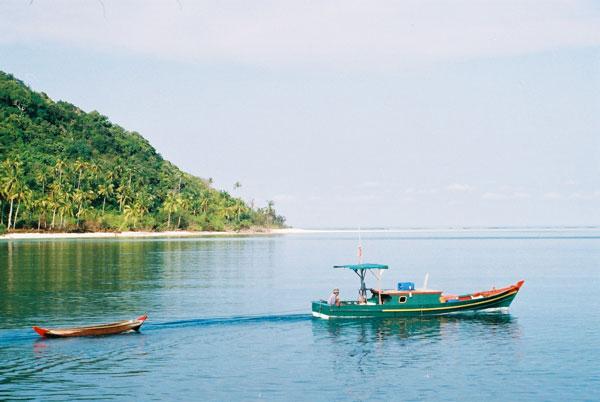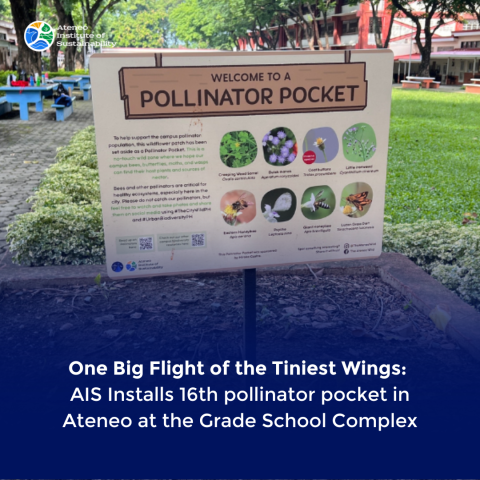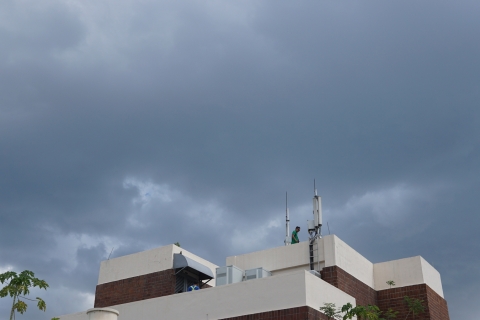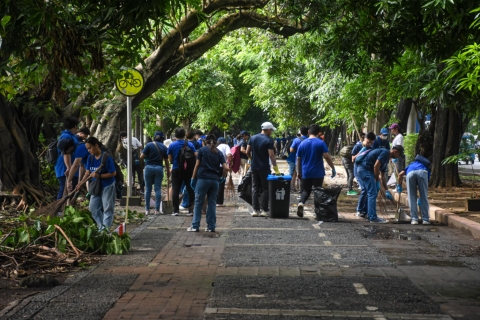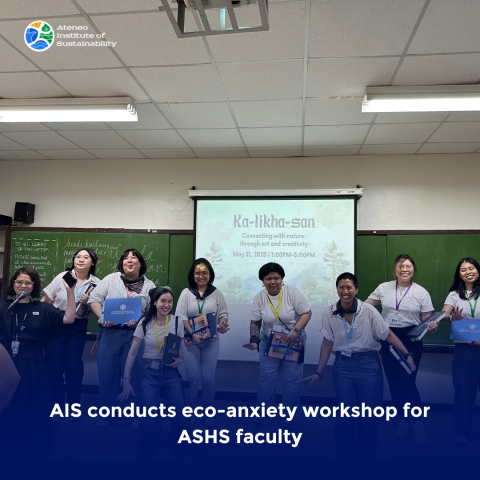One Small Battle won; a War, indeed a Planet, lost
19 Aug 2019 | Captain Warren Blake
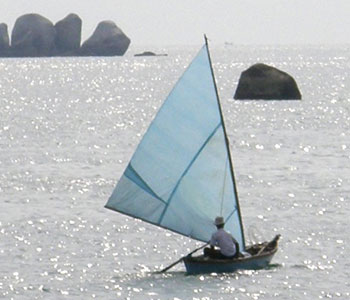
(Captain Blake is the Skipper of “Four Friends,” the schooner of NUS sailing voyages)
In stories from my earlier years of exploring the myriad isles of the South China Sea, I described several encounters with some of the Sea Nomads, wanderers in that vast marine world, in particular the Orang Laut, Men of the Sea, “Sea Gypsies” in the popular view.
After three decades of further voyages I can now look back with some understanding of the slow but inexorable decline of this once robust, self-sufficient way of seafaring life.
This life, when I first met it some 40 years ago was a mainly nomadic one, at least during the benign months of the South Monsoon, from May to October. This was the season when the Orang Laut wandered in sailing perahus, in later years motorised, with a flotilla of tiny dugout canoes in tow, from island to island, reef to reef, across a broad swathe of the sea from the Natunas Archipelago in 4 degrees North, to the Karimata Islands in 2 degrees South.
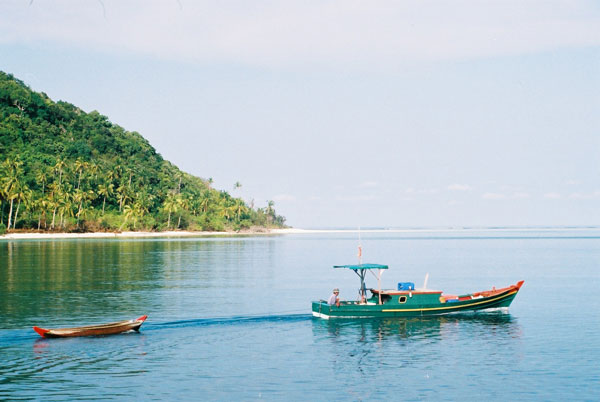
Their unequalled knowledge of the riches of the sea, and their unrivalled skill in hooking, netting, harpooning or diving on one breath to scoop up every edible species, and some decorative ones, provided their sole means of support. They preserved their catch with salt, a commodity which they sometimes produced themselves in shallow pans behind the beach crest.
They dried and salted the flesh of the grouper, snapper, carang, hump-head wrasse, octopus, shark, turtle, squid, the giant clam, (of which the muscle alone, alas, as the solely edible, tiny part); the meat, as well as the colourful carapaces of the Trochus, Trident and Helmet shells, plus numerous other species.
The surplus of this bounty, after feeding their families, was carefully tended, kept dry, periodically salted again, in order to sustain them through four months of the North East Monsoon, from December to March, when strong winds and cloudy, rainy skies made sailing and navigation in their fragile vessels dangerous.
These harsh months were spent ashore, variously in the Badas Islands group, in the South East corner, or in islands of the Anambas Archipelago, in the North West corner of their range. There they depended solely on their surplus of dried fish products as food, and for barter for rice, cooking oil, diesel oil, and other necessities. They lived in small shacks of mangrove poles with thatched roofs and walls of coco-palm fronds to shelter them from the daily rain squalls. Their only activity during this period was the repair of their boats, their nets, and the telling of stories by the elders, the sole schooling for the children.
One story illustrates the harshness of this life. My ketch, Four Friends, was engaged in a search for ship-wrecks in company with John Guthrie’s schooner Dwyn Wen. We were working at Acasta Shoal, a solitary rock awash at high tide, that has always offered a great danger to shipping. Scattered around that rock, in various depths of water, we found the Rajah Brooke, a steamer wrecked there in 1896, a modern ship of 1974, a totally unknown big ship NW of the rock in 80 metres of water, and therefore hidden from investigation, and some hints of a ship of the T’ang Dynasty, of about the year 800.
On some of our expeditions to this site, John brought his young family along. The two small girls, Daphne, 6, and Cecile, 3, became, of course, bored with the life on board, with their father spending most of the daylight hours underwater. We took them to the nearby island of Pengibu, where the Orang Laut had set up a temporary camp ashore while they fished the island’s reef. Daphne and Cecile spent the daylight hours of several days on shore with their Mum, Nanou, and in the process became friends, and played with children of their own age on the island.
On a subsequent expedition, Daphne and Cecile went in the rubber boat with their mother to visit their little friends on Pangibu, proudly carrying colouring books, coloured pens, and various other gifts. They came back later distraught and bewildered, for two of their closest friends, both girls of about their ages, had died of a dysentery-like disease during the few months since their last visit. Daphne and Cecile, of such youth and sheltered upbringing, were scarcely able to comprehend the nature of life, and death…they dimly realized only that the lives of their friends were “finished!”. The parents of the lost children, and their small community, were sadly only too accustomed to such losses.
Some years later Four Friends visited another island further to the Southeast, Tokong Kemudi, where I had first met the characters in my story “A Memorable Lunch” years before. There was a fairly large encampment of Orang Laut behind the palms of the beach front, and I took my charter guests, all divers from Europe, ashore to meet them. My guests had heard my stories of the life of these nomads of the sea.
My Sea Gypsy friends, numbering about 70 all told, were suffering a severe crisis of virtual starvation. For the past two weeks they had been surviving on coconuts alone, and many were suffering from debilitating dysentery. I asked why they had caught no fish? They told us that there were no fish left to catch, because “dynamite boats” from the Riau Islands had been blasting the reefs and scooping up as many dead fish as possible, leaving a wasteland underwater in which every living thing, even shellfish and anemones were killed and buried.
My diver guests were appalled. We were, at that stage on day 18 of a 21 day diving expedition around all the island groups of the South China Sea, and they insisted that we must take ashore every last scrap of food, that they would cheerfully go hungry for three days to help my hapless friends. Some of the islanders followed us out to Four Friends, and helped load every manner of provender from rice to biscuits and pasta, from cornflakes to frozen chickens and tinned tuna, and from cooking oil to kerosene and diesel into our tender.
While we thus engaged, the Orang Laut, with their incredibly sharp eyesight, identified an approaching black boat as the pirates who had been devastating their reefs. I saw the possibility of effective intervention of some sort, and asked the island men to stay with me while we pulled the anchor up, and sent our tender onshore with the urgently needed provisions.
I determined to dog the dynamiters closely, to demonstrate at least that their activities were being observed, by taking numerous photos, with notes of the boat’s number, and perhaps by remonstrating with them.
I was already familiar with the methods of dynamite fishing, indeed I had previously described them to my diver guests, who were now agog to see such an outrage, and were all eager to take photos to publish in newspapers back home and in diving magazines.
The mother boat carried the explosives, a small dugout canoe, and a crude paint compressor to provide air to a diver who would dive breathing from a green garden hose gripped between his teeth. He would dive after the explosion in order to scoop up that vast majority of the dead fish that do not float, that sink due to ruptured swim-bladders. The dug-out would carry one “bomb”, in this case a beer bottle filled with “black powder”, crude gunpowder, with a fuse. The canoe would also carry a swimmer equipped with diving mask, whose job was to locate a school of edible fish of sufficient size to warrant using a bomb. The swimmer would direct the canoe directly over the school, signal for the fuse to be lit, and for the bomb to be thrown into the right spot in the water, before hastily scrambling out into the rickety safety of the tiny dugout. This canoe and its occupants would, generally, survive the blast that erupted very close, while the mother vessel, more vulnerable because of her weight, would hang a few tens of metres away.
I edged my 50 ton, ferro-cement, ocean-going ketch close in behind the mother-ship, reasoning that her sturdy construction would make her safer than the wooden mother ship. My divers, with cameras, and four island men all crowded at the bow ready to observe the first blast. I slipped the engine into neutral, and joined my crew.
Our bow now hung almost over the pirate’s stern. I addressed the pirate captain in Indonesian, and asked him what he was doing? He mumbled something incoherent, and then asked me, quite politely, what I was doing? I explained that my friends were from England and Holland, that everybody on our vessel, especially the islanders, were unhappy about what he, the pirate, was doing, and that my friends were ready to take photos to publish in newspapers all around the world to show how people like him, the pirate, were destroying coral reefs and all the life on them.
The pirate explained, still quite politely, that he was merely “catching a few fish” and that it was really no business of ours what an honest fisherman was up to.
Rather more offensively, he then asked why I, an “Orang Puteh” (White Man) was consorting with “black, primitive people?” Somewhat impolitely I suggested that he was “kurang ajar” (lacking in courtesy).
The man in the water became excited, indicating a school of fish below, and the mother ship moved closer to the action, ready to scoop up all floating fish. I moved my ketch to tower over the pirate again.
Now I understood our best gambit. With twelve skilled divers on board, far more mobile in their scuba gear than the sole pirate on the end of a cumbersome air-hose, and carrying their goody bags, we would be able to scoop up most of the fish on the bottom, to the great benefit of our deserving island friends, and to the deserved discomfort of the pirates.
I urged my crew to action, and they all eagerly gathered along the rails, conspicuous in their gear, and in their intentions.
The pirate captain clearly understood our aims, and now he lost his polite composure . He stood up high on his deck house, to be a little less in an inferior position, and brandished another beer bottle full of powder. In a loud voice, and with unmistakable gestures he threatened that if my divers went down after the first bomb “to steal my fish” he would throw another bomb in on top of them, with lethal effect, as we all understood.
Now it was my turn to lose my composure. I rushed back to find my pump-action shot-gun, loaded it with bear-killing ball shot, and stalked to the bow again. I noisily cocked the weapon, pointed it at the pirate, and told him that should he throw a bomb on top of my divers, I would blast his head off. This was the only time in a long life of action where I have actually pointed a loaded gun at anyone.>
with the three quarter-inch gaping muzzle of a 12-gauge shot-gun at close range, the man dropped his bomb on the deck, rather heavily I thought, considering its destructive power. He whistled and gestured at his men in the canoe, and when they were back on board, roared away at full throttle and in bad temper. We watched as the long, black, rakish hull disappeared fast towards the horizon.
This was one small battle won in a war that has long since been lost.
The rampant dynamite fishing in the South China Sea laid waste to most of the coral reefs. This destructive fishing method was bad enough, but even when it had run its natural course, when there were no more schools of fish numerous enough to warrant the use of a bomb, another threat to marine life emerged. Cyanide poisoning was inflicted on the reefs to supply the booming live-fish trade of Hong Kong, Shanghai, and any other city where rich Chinese could afford the extraordinary prices….several hundred $US per kilo of prime grouper. These two assaults reduced fish life, indeed most marine life, to what I estimate to be 5% of its level of the time I first went exploring and diving in these waters. “You should have been here thirty years ago!” is my common lament.
This toxic approach to marine life worked in this way: divers equipped with an enormous syringe of Sodium Cyanide solution would spread out along a coral reef. Even if that reef had previously been heavily dynamited there would still exist a living coral head or two, and the last few remaining grouper would swim to hide under these heads as the diver approached. Several doses of cyanide injected through various crevices would merely stun the large fish, which could then be fished out by hand, strung on the diver’s belt, and dragged along to be revived with clean water. Meanwhile every remaining living organism on or under that coral head would be dying of poison: coral polyps, juveniles of countless fish and crustacean and other invertebrate species, corals, anemones,…the list is endless. The grouper would often be carried by sampan to a well-equipped, foreign financed mother-vessel, and sustained and fed in an oxygenated tank until he reached the restaurants of Kowloon or Pudong.
The extensive damage done by these human methods was compounded by the very complexity of our Mother’s exquisite organization, which became unravelled under the impact. My daughter did her Marine Biology thesis on the Connectivity of Coral systems, and showed clearly that no tropical island, indeed no coral reef, is an island unto itself. In the tropic seas the corals thrive best when there are chains of islands and reefs, swept one way and then the other by the currents of the two opposing Monsoons. In this way larvae, and juveniles are swept along on the current to colonize reefs further downstream, bringing new genes, and new individuals, even new species to neighboring reefs. These beneficiaries return the favours six months later when the Monsoon winds change direction, and with them the currents. So even if a solitary marine sanctuary were to be properly run and protected, it would still slowly starve due to a lack of rejuvenating plankton from afar….and none of the littoral nations of South East Asia has the capability to run a proper island conservation programme, in fact none of them gives a damn about such matters….”make as many bucks now while the going is good, and salt away the proceeds in a Swiss bank” is the secret aim of every politician and businessman in the region. They are mostly aware that they are ruining the sea, and the jungle, but they are consoled by knowing their children will have those Swiss francs to live somewhere else…not in my native New Zealand, I hope!
But my poor friends, the Nomads of the Sea have no francs, no bank accounts, and they mostly have disappeared into the urban slums of Indonesia, poorly equipped culturally, and ill-educated to cope with the corrosive City Life, where their profound knowledge of the Sea and its inhabitants will die with the older ones.
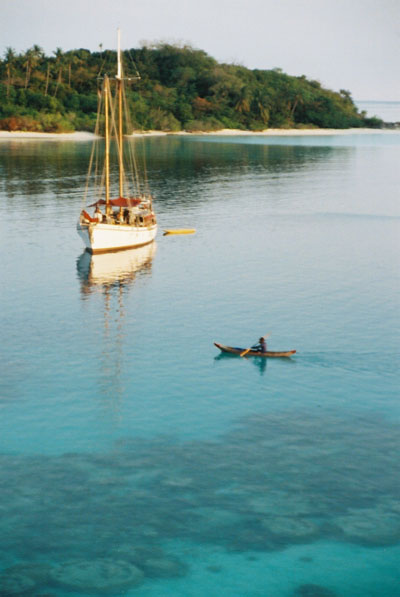
A few eke out a tenuous life on the sea today catching, by hook, the last remaining good-eating fish, and they attempt to keep them alive in perforated blue barrels hanging over the side of their dugouts, hoping to get them thus to the Chinese trader on the main island, who runs an electric compressor to aerate his tanks. In the worst irony, these last Orang Laut can no longer afford to eat such fare, fit now only for Towkays and Taipans, and so survive on the despised meat of clams and helmet shells. The rarity of their occasional catches of grouper only adds to the allure and prestige, it merely whets the appetites of status-conscious Fat Cats in Asian cities, and thus propels the exponential price per kilo…ensuring this and numerous similar trades will lead to extinction…of animal species and minority human cultures.
One of the few: a Sea Gypsy paddles his dugout past Schooner Four Friends in a lagoon in the Anambas Archipelago in 2004. He sold us a medium-size, live grouper for $30, a sum he might aspire to in the first of many steps in the food chain towards a restaurant in Kowloon. We did not begrudge him his “catch”.
The way of life of the Sea Nomads, nurtured since the misty times of Homo erectus hundreds of thousands of years ago, and essentially sustainable if left to itself, is doomed, crushed by Progress. Marine life in the South China Sea is likewise doomed. This fate is a harbinger of the future of Civilization itself. We are good at making money and devising new, ingenious ways of plundering our planet, but we cannot continue much longer. I fear for the lives of my grandchildren.
90% Captain Warren Blake, www.schoonerFourFriends.net; famblake@singnet.com.sg
